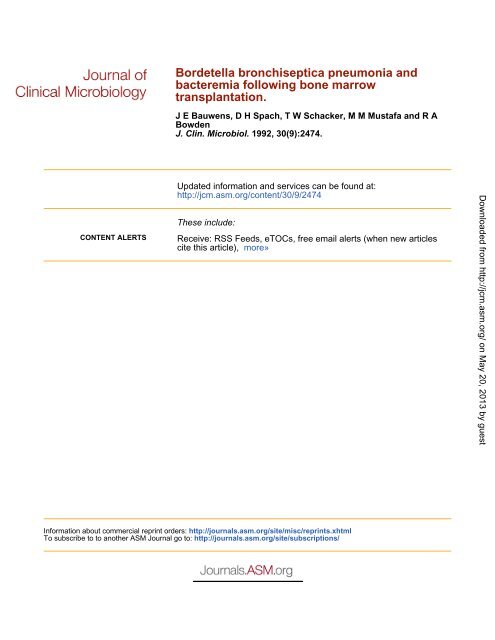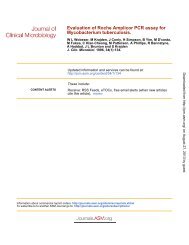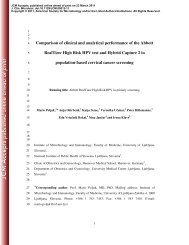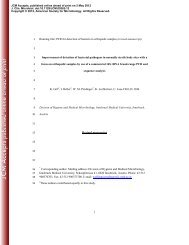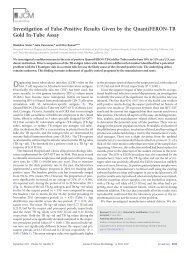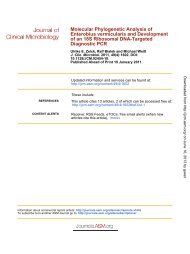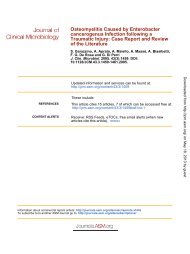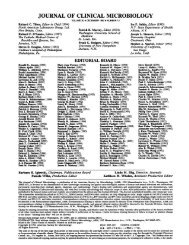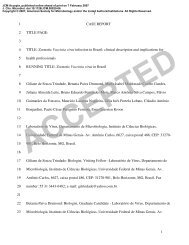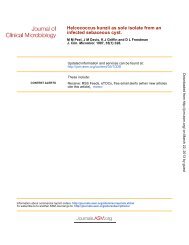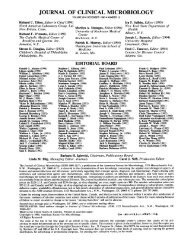Bordetella bronchiseptica Pneumonia and Bacteremia - Journal of ...
Bordetella bronchiseptica Pneumonia and Bacteremia - Journal of ...
Bordetella bronchiseptica Pneumonia and Bacteremia - Journal of ...
Create successful ePaper yourself
Turn your PDF publications into a flip-book with our unique Google optimized e-Paper software.
CONTENT ALERTS<br />
<strong>Bordetella</strong> <strong>bronchiseptica</strong> pneumonia <strong>and</strong><br />
bacteremia following bone marrow<br />
transplantation.<br />
J E Bauwens, D H Spach, T W Schacker, M M Mustafa <strong>and</strong> R A<br />
Bowden<br />
J. Clin. Microbiol. 1992, 30(9):2474.<br />
Updated information <strong>and</strong> services can be found at:<br />
http://jcm.asm.org/content/30/9/2474<br />
These include:<br />
Receive: RSS Feeds, eTOCs, free email alerts (when new articles<br />
cite this article), more»<br />
Information about commercial reprint orders: http://journals.asm.org/site/misc/reprints.xhtml<br />
To subscribe to to another ASM <strong>Journal</strong> go to: http://journals.asm.org/site/subscriptions/<br />
Downloaded from<br />
http://jcm.asm.org/<br />
on May 20, 2013 by guest
JOURNAL OF CLINICAL MICROBIOLOGY, Sept. 1992, p. 2474-2475<br />
0095-1137/92/092474-02$02.00/0<br />
Copyright © 1992, American Society for Microbiology<br />
<strong>Bordetella</strong> <strong>bronchiseptica</strong> <strong>Pneumonia</strong> <strong>and</strong> <strong>Bacteremia</strong><br />
Following Bone Marrow Transplantation<br />
J. ERIC BAUWENS,t DAVID H. SPACH,t* TIMOTHY W. SCHACKER,4<br />
MAHMOUD M. MUSTAFA,§ AND RALEIGH A. BOWDEN<br />
Fred Hutchinson Cancer Research Center, Seattle, Washington 98104<br />
Received 19 February 1992/Accepted 3 June 1992<br />
BordeteUa bronchiseptca is a frequent cause <strong>of</strong> respiratory infections in animals but rarely causes disease in<br />
humans. We describe a patient with B. <strong>bronchiseptica</strong> pneumonia <strong>and</strong> bacteremia that developed following<br />
bone marrow transplantation. B. <strong>bronchiseptica</strong> infection persisted despite antimicrobial therapy <strong>and</strong> may have<br />
progressed because <strong>of</strong> the combined effects <strong>of</strong> the patient's underlying immunosuppression <strong>and</strong> the antimicrobial<br />
antagonism between doxycycline <strong>and</strong> cipr<strong>of</strong>loxacin.<br />
<strong>Bordetella</strong> <strong>bronchiseptica</strong>, a small, pleomorphic, gramnegative<br />
coccobacillus, causes atrophic rhinitis in swine,<br />
snuffles in rabbits, <strong>and</strong> kennel cough in dogs (10, 18).<br />
Humans, however, are rarely infected with this organism.<br />
When infections in humans occur, they are <strong>of</strong>ten acquired<br />
through animal contact <strong>and</strong> typically involve immunocompromised<br />
patients (18). The spectrum <strong>of</strong> immunocompromised<br />
patients who have developed B. <strong>bronchiseptica</strong> infection<br />
includes patients with malignancies such as Hodgkin's<br />
disease (17) or chronic lymphocytic leukemia (1), one cardiac<br />
transplantation patient (4), one patient with AIDS (7),<br />
<strong>and</strong> debilitated alcoholics (9, 12). Our report <strong>of</strong> a bone<br />
marrow transplantation patient with B. <strong>bronchiseptica</strong> infection<br />
exp<strong>and</strong>s the spectrum <strong>of</strong> immunocompromised hosts<br />
who have developed infections with B. <strong>bronchiseptica</strong> <strong>and</strong><br />
illustrates the potential adverse effects <strong>of</strong> antimicrobial antagonism.<br />
Case report. A 20-year-old white female with acute myelogenous<br />
leukemia was admitted to the Fred Hutchinson<br />
Cancer Research Center for allogeneic bone marrow transplantation.<br />
At the time <strong>of</strong> admission, physical examination<br />
revealed a temperature <strong>of</strong> 38°C. Initial laboratory studies<br />
showed an absolute neutrophil count <strong>of</strong> 0.2 x 109/liter,<br />
hematocrit <strong>of</strong> 30.0%, <strong>and</strong> a platelet count <strong>of</strong> 21 x 109/liter.<br />
Following preparative chemotherapy with cyclophosphamide,<br />
60 mg/kg <strong>of</strong> body weight per day for 2 days, <strong>and</strong> total<br />
body irradiation for 4 days, the patient received the donor<br />
marrow on 6 September 1991. Throughout the patient's<br />
hospital course she received fluctuating doses <strong>of</strong> cyclosporin<br />
<strong>and</strong> prednisone as prophylaxis for graft-versus-host disease.<br />
Ten days following the bone marrow transplantation, the<br />
patient developed orthopnea, cough, <strong>and</strong> conjunctival injection.<br />
A chest radiograph demonstrated no abnormality. At<br />
the time, the patient was receiving imipenem <strong>and</strong> vancomycin.<br />
On day 11 posttransplantation, coarse, "honking" rhonchi<br />
were auscultated in the chest, particularly on the left side.<br />
* Corresponding author.<br />
t Present address: Division <strong>of</strong> Infectious Diseases, ZA-89, Harborview<br />
Medical Center, 325 Ninth Avenue, Seattle, WA 98104.<br />
t Present address: Division <strong>of</strong> Infectious Diseases, ZA-00, Harborview<br />
Medical Center, Seattle, WA 98104.<br />
§ Present address: Division <strong>of</strong> Hematology-Oncology, Department<br />
<strong>of</strong> Pediatrics, Southwestern Medical Center, University <strong>of</strong><br />
Texas, Dallas, TX 75235.<br />
2474<br />
Vol. 30, No. 9<br />
One day later, the patient complained <strong>of</strong> shortness <strong>of</strong> breath<br />
<strong>and</strong> a productive cough. Gram staining <strong>of</strong> sputum revealed<br />
no polymorphonuclear cells or microorganisms. A chest<br />
radiograph demonstrated bilateral pulmonary infiltrates, <strong>and</strong><br />
a computed tomographic scan <strong>of</strong> the chest demonstrated<br />
consolidation in the left lower lobe with an associated small<br />
pleural effusion.<br />
At 15 days posttransplantation, the patient remained neutropenic<br />
<strong>and</strong> underwent bronchoscopic examination by<br />
bronchoalveolar lavage (BAL); pr<strong>of</strong>use secretions were<br />
noted, particularly in the left lower lobe bronchus. Gram<br />
staining <strong>of</strong> the BAL specimen demonstrated alveolar macrophages<br />
<strong>and</strong> bronchial epithelial cells but no microorganisms.<br />
Intravenous cipr<strong>of</strong>loxacin, 300 mg twice daily, <strong>and</strong><br />
tobramycin, 90 mg every 8 h, were added to the patient's<br />
antimicrobial regimen.<br />
Two days later, the BAL specimen grew more than 20,000<br />
CFU <strong>of</strong> an <strong>of</strong>f-white or buff-colored gram-negative rod per<br />
ml. The organism was positive in tests for oxidase, citrate<br />
utilization, <strong>and</strong> urea hydrolysis. The Gram Negative Identification<br />
card (Vitek System Co., St. Louis, Mo.) <strong>and</strong> the<br />
Rapid NFT (API System SA, Montalieu-Vercieu, France)<br />
identified the organism as B. <strong>bronchiseptica</strong>. Upon further<br />
questioning, the patient revealed that several days prior to<br />
admission she had contact with a dog that had a barking<br />
cough. Cipr<strong>of</strong>loxacin was continued <strong>and</strong> intravenous doxycycline,<br />
100 mg twice daily, was added. Imipenem <strong>and</strong><br />
tobramycin were discontinued. The patient improved over<br />
the next 10 days, <strong>and</strong> her neutropenia resolved on day 24<br />
posttransplantation. She remained afebrile until posttransplantation<br />
day 37, when she developed a temperature <strong>of</strong><br />
39°C. A repeat chest computed tomographic scan revealed a<br />
cavitary lesion in the left lower lobe.<br />
Forty-five days posttransplantation, B. <strong>bronchiseptica</strong> <strong>and</strong><br />
Aspergillus fumigatus were isolated from a sputum specimen.<br />
On posttransplantation day 47, the patient underwent<br />
resection <strong>of</strong> the left lower lobe cavitary lesion, <strong>and</strong> A.<br />
fumigatus was the only organism isolated. Tissue stains,<br />
however, revealed small numbers <strong>of</strong> gram-negative, coccobacillary<br />
organisms. Sputum cultures obtained on posttransplantation<br />
days 49 <strong>and</strong> 50 again demonstrated B. <strong>bronchiseptica</strong>.<br />
B. <strong>bronchiseptica</strong> was isolated from blood cultures<br />
drawn on 4 consecutive days (beginning on posttransplantation<br />
day 53). Echocardiography had been performed on<br />
posttransplantation day 30, but it did not demonstrate any<br />
valvular lesions. The patient died on posttransplantation day<br />
Downloaded from<br />
http://jcm.asm.org/<br />
on May 20, 2013 by guest
VOL. 30, 1992<br />
57 because <strong>of</strong> multi-organ system failure. No autopsy was<br />
granted.<br />
Microbiologic investigation. Antimicrobial susceptibility<br />
testing by the Kirby-Bauer disk method showed the original<br />
B. <strong>bronchiseptica</strong> isolate from the BAL specimen to be<br />
susceptible to amikacin, cefoperazone, ceftazidime, imipenem,<br />
mezlocillin, piperacillin, ticarcillin-clavulanate, cipr<strong>of</strong>loxacin,<br />
trimethoprim-sulfamethoxazole, polymyxin B,<br />
<strong>and</strong> tobramycin. Broth dilution MICs <strong>and</strong> MBCs were performed<br />
on the initial isolate obtained from the BAL specimen<br />
<strong>and</strong> the first isolate obtained from blood. The MICs <strong>of</strong><br />
cipr<strong>of</strong>loxacin for the two isolates were 0.25 <strong>and</strong> 1.0 ,ug/ml,<br />
respectively. The MBCs were 0.5 <strong>and</strong> >1.0 ,g/ml, respectively.<br />
The MICs <strong>of</strong> doxycycline for the two isolates were<br />
0.125 <strong>and</strong> 4.0 pg/ml, respectively; the MBCs were >4.0 <strong>and</strong><br />
>32 p,g/ml, respectively. Synergy testing by the checkerboard<br />
method (13) showed that the combination <strong>of</strong> cipr<strong>of</strong>loxacin<br />
<strong>and</strong> doxycycline exhibits antagonism at both the inhibitory<br />
<strong>and</strong> bactericidal levels.<br />
Twenty-five cases <strong>of</strong> B. <strong>bronchiseptica</strong> infection have<br />
previously been described in humans (18). Among these<br />
patients, the respiratory tract has most frequently been<br />
involved, with a range <strong>of</strong> clinical manifestations such as<br />
sinusitis, tracheobronchitis, whooping cough, <strong>and</strong> pneumonia<br />
being noted (18). Radiographic appearances <strong>of</strong> lower<br />
respiratory tract infections have included diffuse infiltrates<br />
(1), interstitial pneumonia (4), <strong>and</strong> lobar pneumonia (14).<br />
Seven cases <strong>of</strong> bacteremia, including two cases <strong>of</strong> endocarditis<br />
(11, 15) <strong>and</strong> two cases <strong>of</strong> concomitant pneumonia<br />
(8, 9), have been attributed to B. <strong>bronchiseptica</strong> infections<br />
(6, 8, 11, 12, 16). Other clinical manifestations have included<br />
peritonitis <strong>and</strong> meningitis (2, 3).<br />
The optimal therapy for B. <strong>bronchiseptica</strong> infections has<br />
not been established. In vitro susceptibility testing may not<br />
correlate with in vivo efficacy. Nevertheless, recent in vitro<br />
antimicrobial susceptibility testing suggests that aminoglycosides,<br />
antipseudomonal penicillins, tetracyclines, <strong>and</strong><br />
chloramphenicol are the most effective agents (18). Some<br />
difficulty in treating B. <strong>bronchiseptica</strong> may occur because<br />
<strong>Bordetella</strong> species produce an enzyme, adenylate cyclase,<br />
that enters host polymorphonuclear cells <strong>and</strong> macrophages<br />
<strong>and</strong> disrupts chemotaxis, superoxide production, <strong>and</strong> bacterial<br />
killing (5).<br />
The patient we describe represents the first report <strong>of</strong> B.<br />
<strong>bronchiseptica</strong> infection following bone marrow transplantation.<br />
Our patient's history suggested that her infection<br />
began as an upper respiratory tract infection acquired<br />
through contact with an ill dog. Her infection progressed to<br />
pneumonia <strong>and</strong> bacteremia. The persistence <strong>of</strong> her infection<br />
occurred despite antimicrobial therapy <strong>and</strong> may have resulted<br />
from a combination <strong>of</strong> the following three factors: the<br />
patient's underlying immunosuppression, the ability <strong>of</strong> B.<br />
<strong>bronchiseptica</strong> to inhibit leukocyte function, <strong>and</strong> antimicrobial<br />
antagonism between cipr<strong>of</strong>loxacin <strong>and</strong> doxycycline. The<br />
contribution <strong>of</strong> each <strong>of</strong> these factors is uncertain; but given<br />
the patient's persistent immunosuppression <strong>and</strong> the failure<br />
<strong>of</strong> multiple antibiotics, including imipenem, tobramycin,<br />
cipr<strong>of</strong>loxacin, <strong>and</strong> doxycycline, it is likely that the immunosuppression<br />
played the most important role. The course <strong>of</strong><br />
infection in the patient described here illustrates the poten-<br />
NOTES 2475<br />
tial seriousness <strong>of</strong> B. <strong>bronchiseptica</strong> infections in immunosuppressed<br />
hosts <strong>and</strong> suggests that treatment <strong>of</strong> B. <strong>bronchiseptica</strong><br />
infections with combined antimicrobial therapy may,<br />
in certain instances, contribute to a poor clinical outcome.<br />
Physicians should be aware <strong>of</strong> the potential for B. <strong>bronchiseptica</strong><br />
infections in immunosuppressed patients who have<br />
contact with sick pets.<br />
We gratefully acknowledge the microbiologic assistance provided<br />
by Russ Schwartz, John Quick, <strong>and</strong> Sue Swanzy.<br />
REFERENCES<br />
1. Buggy, B. P., F. C. Brosius, R. M. Bogin, C. A. Koller, <strong>and</strong> D. R.<br />
Schaberg. 1987. <strong>Bordetella</strong> <strong>bronchiseptica</strong> pneumonia in a patient<br />
with chronic lymphocytic leukemia. South. Med. J. 80:<br />
1187-1189.<br />
2. Byrd, L. H., L. Anama, M. Gutkin, <strong>and</strong> H. Chmel. 1981.<br />
<strong>Bordetella</strong> <strong>bronchiseptica</strong> peritonitis associated with continuous<br />
ambulatory dialysis. J. Clin. Microbiol. 14:232-233.<br />
3. Chang, S. M. 1950. Pertussis due to <strong>Bordetella</strong> <strong>bronchiseptica</strong>.<br />
Case report. Pediatrics 6:227-228.<br />
4. Chauncey, J. B., <strong>and</strong> D. R. Schaberg. 1990. Interstitial pneumonia<br />
caused by <strong>Bordetella</strong> <strong>bronchiseptica</strong> in a heart transplant<br />
patient. Transplantation 49:81-83.<br />
5. Confer, D. L., <strong>and</strong> J. W. Eaton. 1982. Phagocytic impotence<br />
caused by an invasive bacterial adenylate cyclase. Science<br />
217:948-950.<br />
6. Dale, A. J. D., <strong>and</strong> J. E. Geraci. 1961. Mixed cardiac valvular<br />
infections: report <strong>of</strong> case <strong>and</strong> review <strong>of</strong> literature. Proc. Staff<br />
Meet. Mayo. Clin. 36:288-294.<br />
7. Decker, G. R., J. P. Lavelle, P. N. Kumar, <strong>and</strong> P. F. Pierce.<br />
1991. <strong>Pneumonia</strong> due to <strong>Bordetella</strong> <strong>bronchiseptica</strong> in a patient<br />
with AIDS. Rev. Infect. Dis. 13:1250-1251.<br />
8. Gardner, P., W. B. Griffin, M. N. Swartz, <strong>and</strong> L. J. Kunz. 1970.<br />
Nonfermentative gram-negative bacilli <strong>of</strong> nosocomial interest.<br />
Am. J. Med. 48:735-749.<br />
9. Ghosh, H. K, <strong>and</strong> J. Tranter. 1979. <strong>Bordetella</strong> bronchicanis<br />
(<strong>bronchiseptica</strong>) infection in man: review <strong>and</strong> a case report. J.<br />
Clin. Pathol. 32:546-548.<br />
10. Goodnow, R. A. 1980. Biology <strong>of</strong> <strong>Bordetella</strong> <strong>bronchiseptica</strong>.<br />
Microbiol. Rev. 44:722-738.<br />
11. Jones, M. 1950. Subacute bacterial endocarditis <strong>of</strong> nonstreptococci<br />
etiology, a review <strong>of</strong> the literature <strong>of</strong> the thirteen-year<br />
period 1936-1948 inclusive. Am. Heart J. 40:96-98.<br />
12. Katzenstein, D. A., L. Ci<strong>of</strong>alo, <strong>and</strong> M. C. Jordan. 1984. <strong>Bordetella</strong><br />
<strong>bronchiseptica</strong> bacteremia. West. J. Med. 140:96-98.<br />
13. Krogstad, D. J., <strong>and</strong> R. C. Moellering. 1980. Combination <strong>of</strong><br />
antibiotics, mechanisms <strong>of</strong> interaction against bacteria, p. 298-<br />
341. In V. Lorian (ed.), Antibiotics in laboratory medicine, 1st<br />
ed. The Williams & Wilkins Co., Baltimore.<br />
14. Reina, J., A. Bassa, I. Llompart, N. Bormll, J. Gomez, <strong>and</strong> A.<br />
Serra. 1991. <strong>Pneumonia</strong> caused by <strong>Bordetella</strong> <strong>bronchiseptica</strong> in<br />
a patient with a thoracic trauma. Infection 19:46-48.<br />
15. Sinnott, J. T., C. Blazejowski, <strong>and</strong> M. D. Bazzini. 1989. <strong>Bordetella</strong><br />
<strong>bronchiseptica</strong> endocarditis: a tale <strong>of</strong> a boy <strong>and</strong> his dog.<br />
Clin. Microbiol. Newsl. 14:111-112.<br />
16. Snell, J. J. S. 1973. The distribution <strong>and</strong> identification <strong>of</strong><br />
non-fermentative bacteria. Public Health Lab. Serv. Monogr.<br />
Ser. 4:1-45.<br />
17. Stoll, D. B., S. A. Murphey, <strong>and</strong> S. K Balias. 1981. <strong>Bordetella</strong><br />
<strong>bronchiseptica</strong> infection in stage IV Hodgkin's disease. Postgrad.<br />
Med. J. 57:723-724.<br />
18. Woolfrey, B. F., <strong>and</strong> J. A. Moody. 1991. Human infections<br />
associated with <strong>Bordetella</strong> <strong>bronchiseptica</strong>. Clin. Microbiol.<br />
Rev. 4:243-255.<br />
Downloaded from<br />
http://jcm.asm.org/<br />
on May 20, 2013 by guest


